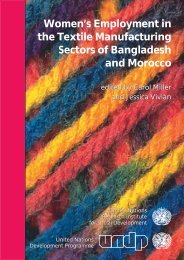The Politics of Gender and Reconstruction in Afghanistan
The Politics of Gender and Reconstruction in Afghanistan
The Politics of Gender and Reconstruction in Afghanistan
Create successful ePaper yourself
Turn your PDF publications into a flip-book with our unique Google optimized e-Paper software.
EVOLVING INSTITUTIONAL FRAMEWORKS AND WOMEN’S RIGHTS: POTENTIALS AND LIMITATIONS<br />
Women needed the permission <strong>of</strong> men both to vote <strong>and</strong> to participate <strong>in</strong> the women’s shuras or committees. This<br />
could prevent elected women from actually participat<strong>in</strong>g, <strong>and</strong> was <strong>in</strong>deed found to do so <strong>in</strong> some villages. In<br />
some districts the apparently high numbers <strong>of</strong> female members <strong>in</strong> CDCs did not reflect actual participation <strong>in</strong><br />
jo<strong>in</strong>t decision-mak<strong>in</strong>g with regards to project proposals <strong>and</strong> prioritization. Where there were jo<strong>in</strong>t committees,<br />
elected female members were <strong>of</strong>ten marg<strong>in</strong>alized by the men <strong>and</strong> not <strong>in</strong>vited to participate <strong>in</strong> CDC meet<strong>in</strong>gs. 50<br />
A more encourag<strong>in</strong>g f<strong>in</strong>d<strong>in</strong>g was that attitudes to women’s participation were not homogenous, with different<br />
levels <strong>of</strong> acceptance <strong>in</strong> different districts. A number <strong>of</strong> factors, such as levels <strong>of</strong> formal education, degrees <strong>of</strong><br />
exposure to the outside world through experiences <strong>of</strong> displacement, <strong>and</strong> membership <strong>of</strong> different ethnic <strong>and</strong><br />
confessional groups, appear to have an <strong>in</strong>fluence on women’s levels <strong>of</strong> participation. 51<br />
A case study carried out <strong>in</strong> Panjao (Hazarajat) corroborates some <strong>of</strong> the f<strong>in</strong>d<strong>in</strong>gs about the effects <strong>of</strong> age <strong>and</strong><br />
social status (deriv<strong>in</strong>g from property ownership or l<strong>in</strong>eage) on participation at the household <strong>and</strong> community<br />
levels (Wakefield 2004). <strong>The</strong> belief that women lack the necessary “knowledge” to participate <strong>in</strong> decisionmak<strong>in</strong>g<br />
(except <strong>in</strong> daily matters concern<strong>in</strong>g their households) is <strong>of</strong>ten put forward as a justification for their<br />
exclusion. 52<br />
<strong>The</strong>se observations on women’s community-level participation conta<strong>in</strong> broader lessons for local <strong>and</strong> national<br />
electoral processes <strong>in</strong> <strong>Afghanistan</strong>. <strong>The</strong>re were signs that women were be<strong>in</strong>g marg<strong>in</strong>alized from voter-education<br />
projects because <strong>of</strong> both the logistic difficulties <strong>of</strong> reach<strong>in</strong>g them <strong>and</strong> fears <strong>in</strong> some quarters that <strong>in</strong>volv<strong>in</strong>g<br />
rural women could upset conservative sensibilities <strong>in</strong> the prov<strong>in</strong>ces <strong>and</strong> stall the process <strong>of</strong> reconstruction<br />
(ACSF/swisspeace 2003). An exclusive focus on civic education tra<strong>in</strong><strong>in</strong>g may also miss elements that are<br />
essential to underst<strong>and</strong><strong>in</strong>g the actual dynamics <strong>of</strong> women’s access to the polls, which is rout<strong>in</strong>ely mediated by<br />
male gatekeepers who allow or disallow access. 53 It is therefore <strong>in</strong>cumbent upon election planners <strong>and</strong> policy<br />
makers to devise more creative ways <strong>of</strong> engag<strong>in</strong>g with male community leaders <strong>and</strong> elders so as to ensure that<br />
provisions for women’s rights to political participation can translate from pr<strong>in</strong>ciple to reality.<br />
Moreover, the sociocultural constra<strong>in</strong>ts that impede women from vot<strong>in</strong>g or st<strong>and</strong><strong>in</strong>g as c<strong>and</strong>idates are not<br />
amenable to change through the quick fix <strong>of</strong> tra<strong>in</strong><strong>in</strong>g or civic education. Longer-term engagement with local<br />
communities <strong>and</strong> a thorough underst<strong>and</strong><strong>in</strong>g <strong>of</strong> the types <strong>of</strong> patronage networks that operate among men,<br />
between men <strong>and</strong> women, <strong>and</strong> among women themselves are essential. A fact that is sometimes conveniently<br />
overlooked is that women, however marg<strong>in</strong>alized, more <strong>of</strong>ten than not share the same political culture as the<br />
men <strong>in</strong> their communities (<strong>in</strong>clud<strong>in</strong>g views about women’s appropriate place <strong>and</strong> conduct). In the absence <strong>of</strong> an<br />
adequate time frame to devise well thought out <strong>and</strong> locally appropriate strategies, the rush to <strong>in</strong>clude women<br />
may backfire <strong>and</strong> <strong>in</strong>advertently produce a harden<strong>in</strong>g <strong>of</strong> attitudes <strong>in</strong> some communities.<br />
50 <strong>The</strong> most strik<strong>in</strong>g example <strong>of</strong>fered was the case <strong>of</strong> a woman accountant who had been elected on the strength <strong>of</strong> her bookkeep<strong>in</strong>g skills but was<br />
excluded from CDC meet<strong>in</strong>gs because they took place at the mosque. <strong>The</strong> choice <strong>of</strong> venue apparently led to her exclusion.<br />
51 Women belong<strong>in</strong>g to the Shi’a Ismaili communities were found to be participat<strong>in</strong>g actively <strong>in</strong> the jo<strong>in</strong>t election <strong>in</strong> Badakhshan prov<strong>in</strong>ce, whereas it<br />
was more difficult to <strong>in</strong>clude Sunni women. Similar experiences were reported regard<strong>in</strong>g Hazaras <strong>in</strong> Bamiyan who are also Shi’as. Pashtun communities<br />
were found to be particularly resistant to women’s participation.<br />
52 This construction also has the quality <strong>of</strong> a self-fulfill<strong>in</strong>g prophecy. To the extent that women—especially the unmarried <strong>and</strong> the young—are kept <strong>in</strong><br />
seclusion, they lead a sheltered existence that cuts them <strong>of</strong>f from any contacts except with their close k<strong>in</strong>. <strong>The</strong> restriction <strong>of</strong> their social horizons coupled<br />
with their lack <strong>of</strong> education is then <strong>in</strong>voked to expla<strong>in</strong> their exclusion on grounds <strong>of</strong> “ignorance”. With advanc<strong>in</strong>g age, both experience <strong>of</strong> life <strong>and</strong> a relaxation<br />
<strong>of</strong> strictures placed on mobility vests women with greater authority, especially with<strong>in</strong> their own households.<br />
53 An Asia Foundation (2004) public op<strong>in</strong>ion poll reported <strong>in</strong> July 2004 that 87 per cent <strong>of</strong> women needed permission from their husb<strong>and</strong>s to vote, <strong>and</strong><br />
18 per cent <strong>of</strong> husb<strong>and</strong>s said they would not allow such participation.<br />
PAGE 29
















